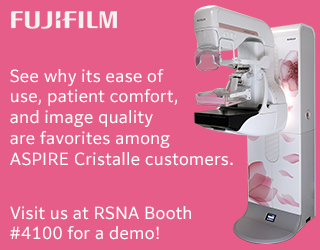|
E-Newsletter • October 2024 |
▼ ADVERTISEMENT

Editor's E-Note
The American Cancer Society estimates that approximately 19,680 women in the United States will be diagnosed with ovarian cancer in 2024, and around 12,740 women in the US will die from it. Earlier detection can help save lives, and this month’s newsletter highlights an ultrasound protocol that demonstrated a 96% detection rate in a study from the United Kingdom.
What types of ultrasound exams does your facility perform? Please let us know on X, formerly known as Twitter, and/or Facebook.
Enjoy the newsletter.
— Dave Yeager, editor |
|
|
| In This E-Newsletter
|
 |
|
|
Ultrasound Test Could Detect 96% of Ovarian Cancers
An ultrasound test that detected 96% of ovarian cancers in postmenopausal women should replace the current standard of care test in the United Kingdom, according to a new study.
In a paper published in Lancet Oncology, research funded by the National Institute for Health and Care Research and led by Professor Sudha Sundar from the University of Birmingham compared all currently available tests to diagnose ovarian cancer in postmenopausal women head-to-head in a high-quality diagnostic test accuracy study.
▼ ADVERTISEMENT

Sundar, a professor of gynecological cancer at the University of Birmingham and consultant in gynecological cancer surgery at Sandwell and West Birmingham NHS Trust, says, “This is the first time that a head-to-head study of all available ovarian cancer tests has been done in the same population. Here, we studied their use with symptomatic, postmenopausal women who are most at risk of this cancer. Our trial found that the IOTA ADNEX ultrasound protocol had the highest sensitivity for detecting ovarian cancer compared to the standard of care and other tests.”
Of the six diagnostic tests investigated, the IOTA ADNEX model, which looks at ultrasound features (how the lump looks on ultrasound), had the best accuracy of all and could detect up to 96% of women with ovarian cancer.
|
Lower-Dose Oropharyngeal Cancer Study Halted
A study aimed at “deintensifying” radiation doses for early-stage HPV-associated oropharyngeal cancer has been halted after it was revealed that patients receiving existing standard radiation doses fared better.
▼ ADVERTISEMENT

New Ablation Strategy Found for Complex Tachycardias
A new cardiac imaging strategy utilizing cardiac MR images is aiding in identifying ventricular tachycardia in patients with postinfarction scarring.
AI Doesn’t Necessarily Boost Medical Practice Efficiency
Researchers at the University Hospital Bonn and the University of Bonn conducted an analysis of AI impact on medical practice efficiency. Their research, published in npj Digital Medicine, revealed there isn’t a definitive boost. |
“This research represents a new imaging technology that surpasses previous limitations and is expected to make a major contribution to disease modeling, personalized treatments, and drug development research using organoids.”
— Mahn Jae Lee, MD, PhD, graduate from the Korea Advanced Institute of Science and Technology Graduate School of Medical Science and Engineering, and first author of a study conducting real-time observation of organoids, 3D mini-organs that imitate the structure and function of human organs |
|
|
COVER STORY
Shifting Guidelines
Experts are discussing ways to break down breast cancer screening barriers, especially in underserved and minority communities.
FEATURE
The Road Ahead?
While mobile MRI machines could expand access to neuroimaging and neuro research, they also raise legal and ethical questions regarding their use.
|
|
|
| Advertising Opportunities |
Have a product or service you want to market to radiology professionals? Utilize the reach of Radiology Today Magazine to accomplish your marketing goals. Email our experienced account executives today at sales@gvpub.com or call 800-278-4400 for more information.
|
| © 2024 Radiology Today Magazine |
|
|